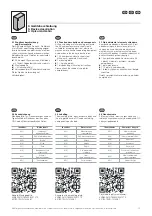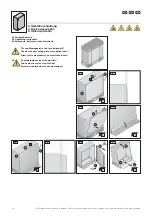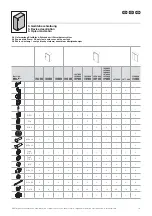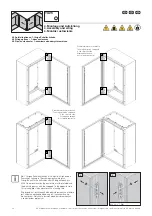
Für das AX-Gehäuse liegt eine Überbeanspruchung vor, wenn
dieses mit geöffneter Tür ohne Abstützung auf dem Rücken
liegt. Hierdurch entstehen sichtbare, bleibende Verformungen.
Dies ist nicht zulässig.
Positioning the AX enclosure on its back with the door open
will cause excessive strain, leading to permanent, visible
deformation. This is inadmissible.
4.1 Anforderungen an den Aufstellort
Vor der Montage ist zu beachten, dass
◾ die Umgebungstemperatur am Aufstellort
nicht höher als +80 °C ist.
◾ die Umgebungstemperatur am Aufstellort
nicht niedriger als –20 °C ist.
◾ die relative Luftfeuchte 50 % bei +40 °C
nicht übersteigt.
Bei niedrigeren Temperaturen dürfen höhere
Luftfeuchtewerte zugelassen werden, z. B.
90 % r. F. bei +20 °C. Kondensatbildung ist
durch geeignete Maßnahmen zu verhindern.
Liegen besondere Betriebsbedingungen
vor, muss die Eignung durch Rittal bestätigt
werden.
Hinweise zur Montage
◾ Halten Sie die auf Seite 42 vorgegebenen
Belastungsangaben ein.
◾ Bei der Montage der Gehäuse ist auf eine
ausreichende Ebenheit der Montageflächen
zu achten.
◾ Halten Sie alle vorgegebenen Drehmoment-
angaben ein. Ein Über- bzw. Unterschreiten
der in dieser Anleitung vorgegebenen Anzu-
gsdrehmomente kann zu Anlagenschäden
oder zu schweren bis hin zu tödlichen
Verletzungen führen.
◾ Vermeiden Sie nicht notwendige Öffnungen
am Schaltschrank. Jede nicht sorgfältig ein-
gebrachte und abgedichtete Öffnung kann
zu einer Reduzierung der Schutzart führen.
◾ Bei einer Wandmontage ist auf eine aus-
reichende Tragfähigkeit zu achten. Hier sind
auch die Hinweise in der Anleitung des
verwendeten Systemzubehörs zu berücksi-
chtigen.
4.1 Site requirements
Prior to assembly, ensure that
◾ the ambient temperature at the installation
site is not higher than +80 °C.
◾ the ambient temperature at the installation
site is not lower than –20 °C.
◾ the relative humidity does not exceed 50%
at +40 °C. Higher humidity levels are permit-
ted at lower temperatures, e.g. 90% relative
humidity at +20 °C. Suitable measures
should be taken to prevent the formation of
condensation.
If used under special operating conditions,
their suitability must be confirmed by Rittal.
Assembly instructions
◾ Observe the load capacities specified
on page 42.
◾ When installing the enclosures the mounting
surfaces must be sufficiently smooth.
◾ Observe all specified torque values. Over- or
undershooting the tensioning torques speci-
fied in these instructions can cause system
damage, severe injuries or even death.
◾ Avoid any unnecessary openings in the
enclosure. Any opening that is not made
and sealed carefully can reduce the degree
of protection.
◾ Ensure adequate carrying capacity for wall
mounting. The notes in the instructions for
the deployed system accessories must also
be observed.
21
AX Kompakt-Schaltschränke, Stahlblech / AX compact enclosures, sheet steel / Kompaktowe obudowy sterownicze AX, blacha stalowa
4. Montage und Aufstellung
4. Assembly and siting
4. Montaż i ustawienie
W przypadku obudów AX położonych bez podpory na tylnej
ścianie z otwartymi drzwiami dochodzi do ich przeciążenia.
Powstają w ten sposób trwałe i widoczne zniekształcenia.
Jest to niedopuszczalne.
4.1 Wymagania odnośnie miejsca usta-
wienia
Przed montażem należy zwrócić uwagę na
to, aby
◾ temperatura otoczenia w miejscu ustawienia
nie była wyższa niż +80 °C.
◾ temperatura otoczenia w miejscu ustawienia
nie była niższa niż -20 °C.
◾ względna wilgotność powietrza otoczenia
nie przekraczała 50% przy maks. tempera-
turze +40°C.
Przy niższych temperaturach dopuszczalna
jest wyższa wilgotność powietrza, np. 90%
przy +20°C. Należy bezwzględnie unikać
kondensacji za pomocą odpowiednich
środków.
Przydatność do szczególnych wymagań eks-
ploatacyjnych wymaga potwierdzenia przez
Rittal.
Wskazówki dotyczące montażu
◾ Muszą być zachowane parametry obciąże-
nia podane na stronie 42.
◾ Podczas instalacji obudowy należy zwra-
cać uwagę na odpowiednie wyrównanie
powierzchni montażowych.
◾ Przestrzegać wszystkich podanych momen-
tów dokręcania. Przekroczenie podanych w
niniejszej instrukcji momentów dokręcania
może prowadzić do uszkodzenia urządzenia,
poważnych obrażeń lub nawet śmierci.
◾ Unikać niepotrzebnych otworów w szafie
sterowniczej. Każdy niestarannie wykonany
i nieprawidłowo uszczelniony otwór może
prowadzić do zredukowania klasy ochrony.
◾ W przypadku montażu na ścianie zwrócić
uwagę na wystarczającą nośność. Należy
tutaj także uwzględnić wskazówki zawarte w
instrukcjach użytych akcesoriów systemo-
wych.
















































